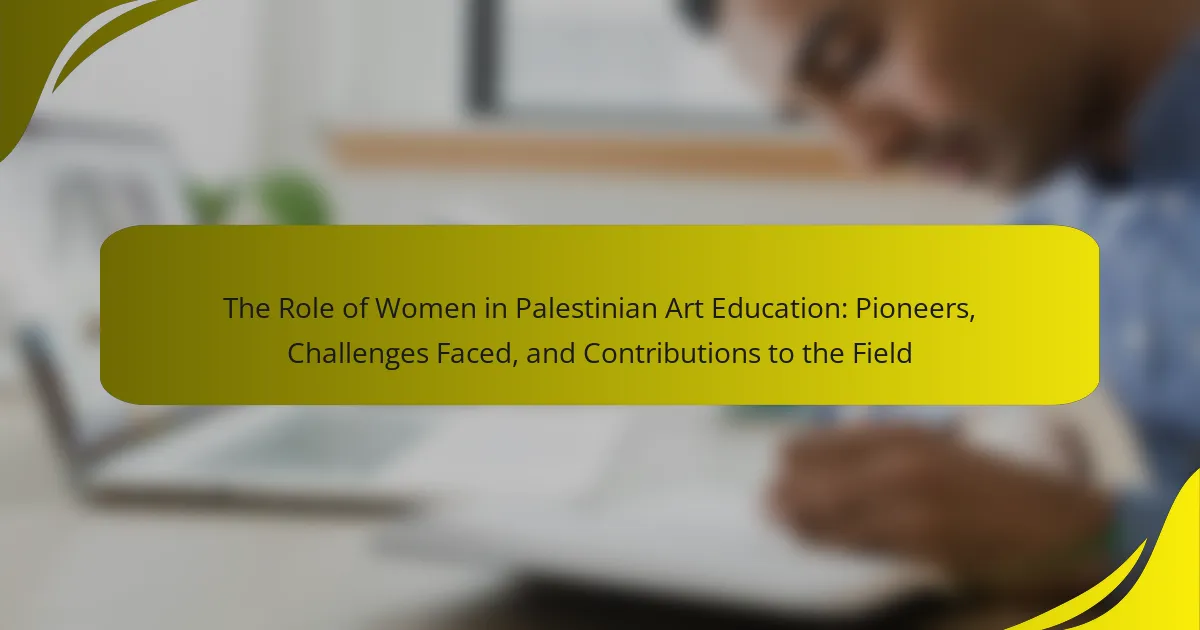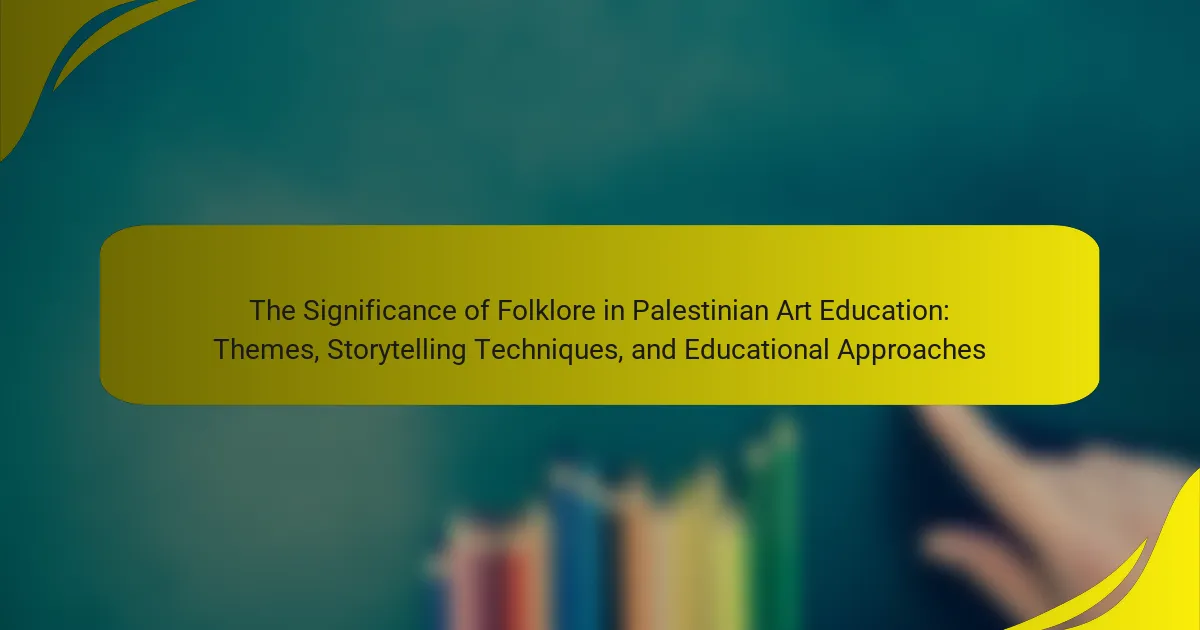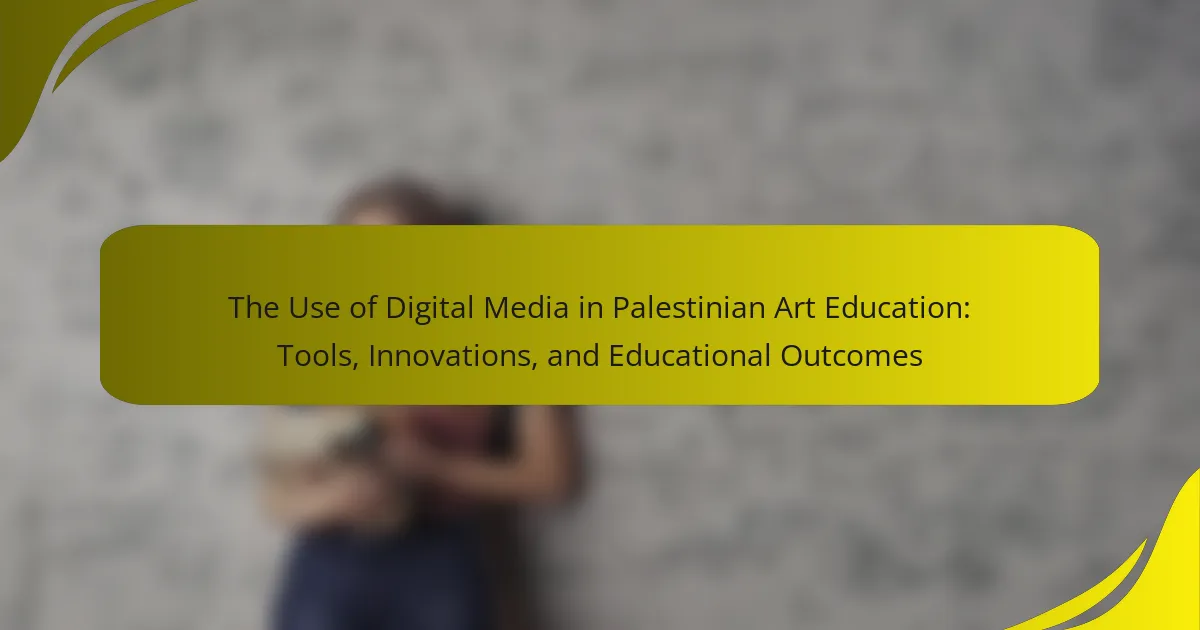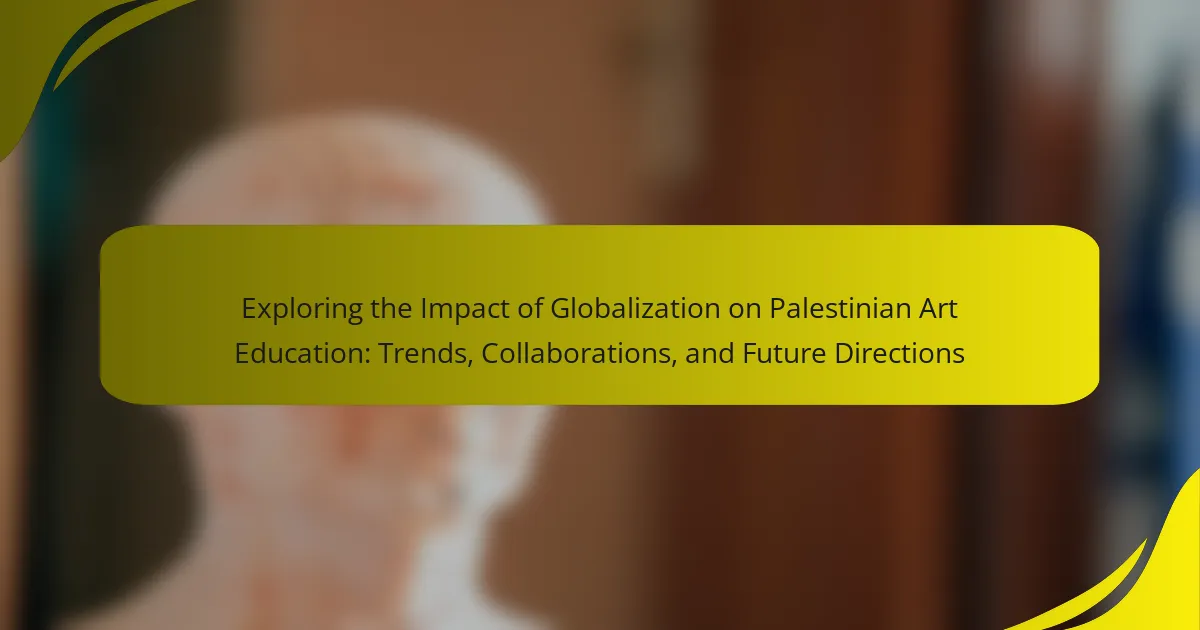Palestinian art education has undergone significant transformation since the early 20th century, evolving from informal practices influenced by traditional crafts to formal institutions like the Bezalel Academy of Arts and Design. The establishment of the Palestinian National Authority in the 1960s and 1970s marked a critical period of investment in cultural institutions and the emergence of influential artists such as Ismail Shammout and Sliman Mansour. Despite facing challenges during the 1980s due to political instability, grassroots movements and community art programs thrived, emphasizing social and political themes. Today, institutions like the International Academy of Art Palestine continue to foster artistic talent, blending traditional and contemporary practices while promoting cultural identity and critical dialogue. The future of Palestinian art education appears promising, bolstered by local and international support, collaborative initiatives, and increased access through digital platforms.
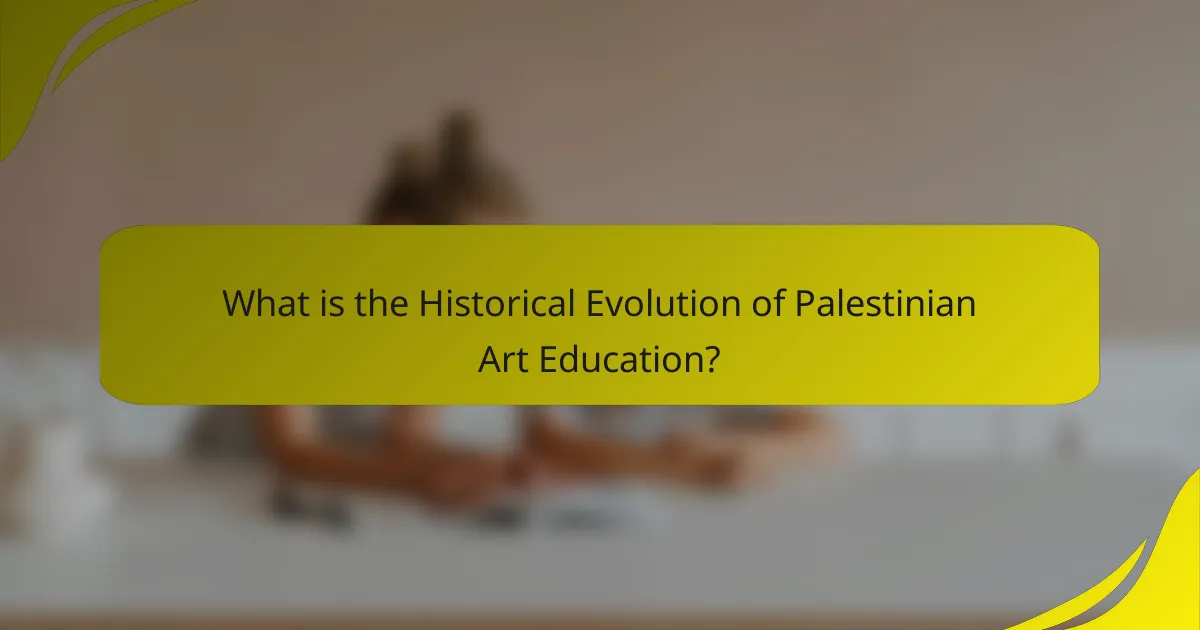
What is the Historical Evolution of Palestinian Art Education?
Palestinian art education has evolved significantly since the early 20th century. Initially, art education was informal and primarily influenced by traditional crafts. In the 1940s and 1950s, formal institutions began to emerge, such as the Bezalel Academy of Arts and Design in Jerusalem. This period saw the introduction of Western artistic principles alongside local traditions.
The 1960s and 1970s marked a pivotal shift with the establishment of the Palestinian National Authority. This led to increased investment in cultural institutions and art education. Notable figures, such as Ismail Shammout and Sliman Mansour, emerged during this time, influencing the curriculum and artistic expression.
In the 1980s, art education faced challenges due to political instability. However, grassroots movements and community art programs flourished, emphasizing social and political themes. The 1990s and 2000s saw the rise of contemporary art practices, integrating global art trends with local narratives.
Today, Palestinian art education continues to adapt, focusing on both traditional and contemporary forms. Institutions like the International Academy of Art Palestine play a crucial role in fostering artistic talent. The historical evolution reflects a blend of resilience and creativity in response to sociopolitical contexts.
How has Palestinian art education developed over time?
Palestinian art education has developed significantly over time, reflecting the socio-political landscape. Initially, art education was informal, primarily rooted in community practices and local traditions. In the mid-20th century, formal institutions began to emerge, influenced by the Palestinian Liberation Movement. The establishment of the Palestine Liberation Organization (PLO) in 1964 led to increased emphasis on cultural identity through art.
In the 1970s, institutions like the Bezalel Academy of Arts and Design in Jerusalem contributed to formal education. The first Palestinian art school, the Al-Quds University Fine Arts Department, was established in the 1990s, promoting contemporary art practices.
The Oslo Accords in the 1990s further facilitated art education through international collaborations. Today, Palestinian art education includes diverse disciplines, integrating traditional and modern techniques. This evolution has fostered a vibrant artistic community, emphasizing cultural resistance and identity.
What key historical events influenced Palestinian art education?
Key historical events that influenced Palestinian art education include the 1948 Nakba, which led to the displacement of many Palestinians and the loss of cultural heritage. This event sparked a focus on preserving Palestinian identity through art. The establishment of the Palestinian Liberation Organization (PLO) in the 1960s emphasized cultural expression as a form of resistance. The First Intifada in the late 1980s further galvanized artistic movements, emphasizing social and political themes in art. Additionally, the Oslo Accords in the 1990s opened new avenues for cultural exchange and education. These events collectively shaped the curriculum and focus of art education in Palestine, intertwining art with national identity and resistance.
How did external factors shape the evolution of art education in Palestine?
External factors significantly influenced the evolution of art education in Palestine. Political instability and conflict have shaped educational policies and curricula. The Israeli occupation has restricted access to resources and institutions. International organizations have intervened, providing funding and support for art programs. Cultural exchanges with foreign institutions introduced new methodologies and perspectives. The diaspora community has contributed to art education through workshops and scholarships. Local artists have often adapted their teaching to reflect social and political realities. These dynamics have created a unique context for art education in Palestine, blending traditional practices with contemporary challenges.
What are the key movements in Palestinian art education?
Key movements in Palestinian art education include the establishment of the Palestine Art Academy in 2005 and the influence of the Intifada on artistic expression. The 1970s saw a rise in community-based art initiatives that aimed to promote cultural identity. In the 1990s, the Oslo Accords led to increased international collaboration in art education. The contemporary movement emphasizes the integration of traditional and modern techniques. These movements reflect the socio-political context of Palestine and aim to foster resilience through art.
Which artistic movements have significantly impacted Palestinian art education?
The artistic movements that have significantly impacted Palestinian art education include modernism, realism, and postmodernism. Modernism introduced new techniques and ideas, encouraging Palestinian artists to explore individual expression. Realism emphasized the depiction of everyday life and social issues, which resonated with Palestinian experiences. Postmodernism challenged traditional narratives and embraced diverse perspectives, influencing contemporary art education. These movements collectively shaped the curriculum and methodologies in Palestinian art institutions. Their influence is evident in the works of prominent Palestinian artists who reflect these styles and philosophies in their art.
How did these movements reflect the socio-political context of their time?
These movements reflected the socio-political context of their time by addressing issues of identity and resistance. Palestinian art movements emerged during periods of occupation and conflict. Artists used their work to express national identity and cultural heritage. The 1960s and 1970s saw art become a tool for political expression. This was a response to the Israeli occupation and the struggle for statehood. The First Intifada in the late 1980s further intensified artistic expressions of resistance. Artists focused on themes of loss, displacement, and resilience. The socio-political climate directly influenced the subject matter and style of the art produced. These movements served as a voice for the Palestinian people during turbulent times.
Who are the influential figures in Palestinian art education?
Influential figures in Palestinian art education include Kamal Boullata, Ismail Shammout, and Mona Hatoum. Kamal Boullata is known for his contributions to art theory and education in Palestine. He played a significant role in establishing art programs in Palestinian universities. Ismail Shammout is recognized for his impactful artwork that reflects Palestinian identity. His teaching influenced many young artists in the region. Mona Hatoum is an internationally acclaimed artist whose work addresses issues of displacement. Her innovative approaches inspire students and educators alike. These individuals have shaped the landscape of art education in Palestine through their artistic practices and educational initiatives.
What contributions did notable artists and educators make to Palestinian art education?
Notable artists and educators have significantly contributed to Palestinian art education by promoting cultural identity and artistic expression. They have established art programs and institutions that focus on Palestinian heritage. Figures like Ismail Shammout and Kamal Boullata have influenced curricula with their unique styles and perspectives. Their works often reflect social and political themes relevant to Palestine. Educators have also integrated traditional techniques with contemporary practices. This blend encourages students to explore their cultural roots while engaging with modern art movements. The establishment of institutions like the International Academy of Art Palestine has further solidified these contributions. These efforts foster a sense of community and resilience through art education in Palestine.
How did these figures influence the curriculum and teaching methods?
These figures significantly influenced the curriculum and teaching methods in Palestinian art education. They introduced innovative concepts that shaped how art was taught. Their emphasis on cultural identity encouraged the integration of local themes into art curricula. They promoted hands-on learning experiences, shifting focus from traditional techniques to contemporary practices. Their advocacy for critical thinking transformed pedagogical approaches. They inspired the incorporation of interdisciplinary studies, linking art with history and social issues. Their impact led to the establishment of art institutions that reflected these values. Overall, their contributions fostered a more inclusive and relevant art education framework.
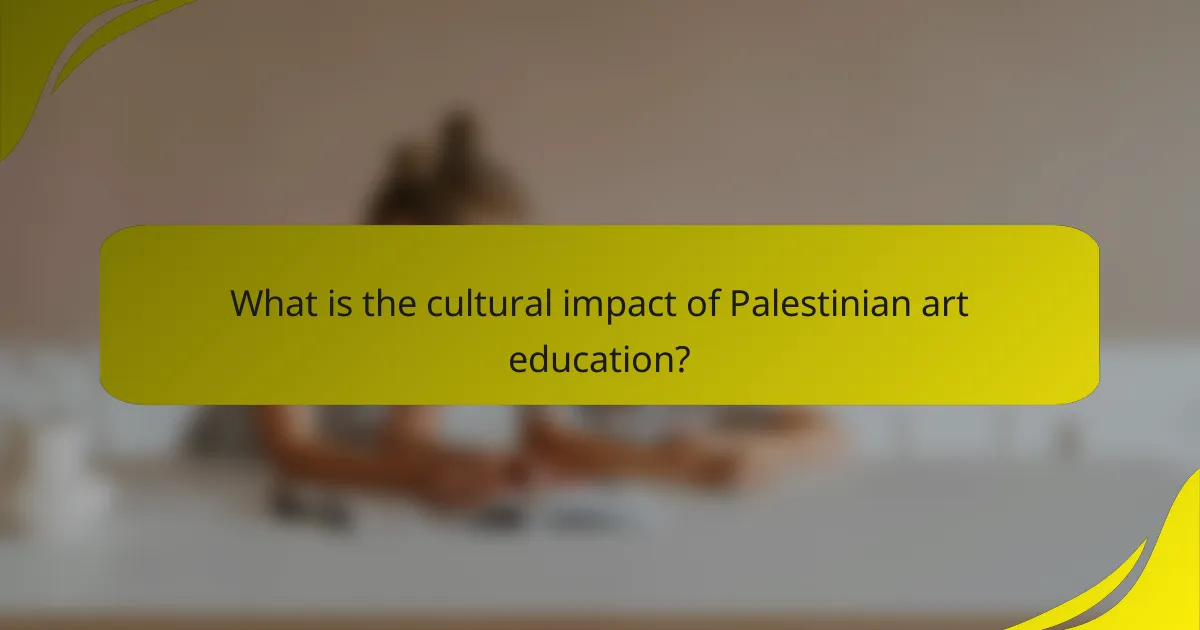
What is the cultural impact of Palestinian art education?
Palestinian art education significantly influences cultural identity and expression. It fosters a sense of community among artists and students. Art education promotes awareness of Palestinian history and heritage. Through creative expression, individuals convey their experiences and struggles. This educational framework nurtures critical thinking and innovation. It encourages dialogue about social and political issues. Art programs often integrate traditional and contemporary practices. This blend enriches the cultural landscape and promotes resilience.
How does Palestinian art education contribute to cultural identity?
Palestinian art education significantly contributes to cultural identity by fostering a sense of belonging and continuity among Palestinians. It emphasizes traditional themes, symbols, and narratives that reflect the unique history and experiences of the Palestinian people. Art education serves as a medium for expressing collective memories and aspirations. Through various forms of art, students engage with their cultural heritage and values. This engagement cultivates pride in their identity and resilience against external influences. Moreover, art education facilitates dialogue about social and political issues relevant to Palestinian society. It encourages critical thinking and creativity, empowering individuals to articulate their identities. Various institutions, such as art schools and community centers, promote these educational initiatives. These institutions often incorporate local artists’ work and teachings, reinforcing cultural connections.
In what ways does art education foster a sense of community among Palestinians?
Art education fosters a sense of community among Palestinians by encouraging collective expression and cultural identity. It provides a platform for individuals to share their experiences and narratives through various art forms. This shared creative process promotes dialogue and understanding among community members. Workshops and collaborative projects often bring together diverse groups, fostering unity. Art education also serves as a means of preserving and celebrating Palestinian heritage. Through exhibitions and performances, artists can showcase their work, reinforcing community ties. Moreover, art education can empower individuals, giving them a voice in societal issues. This empowerment fosters a sense of belonging and solidarity within the community.
How does the representation of Palestinian culture manifest in art education?
The representation of Palestinian culture in art education manifests through various artistic expressions and educational frameworks. Art education incorporates traditional Palestinian motifs, folklore, and historical narratives. These elements serve to educate students about their cultural heritage. Artists often use visual storytelling to convey themes of identity and resistance. Educational programs emphasize the importance of cultural preservation. Workshops and exhibitions showcase Palestinian artists and their work. This creates a platform for dialogue about social and political issues. Furthermore, art education fosters a sense of community and belonging among students.
What challenges has Palestinian art education faced?
Palestinian art education has faced significant challenges due to political instability and conflict. The ongoing occupation has limited access to educational resources and facilities. Many art institutions operate under difficult conditions, impacting their ability to provide quality education. Restrictions on movement hinder students and educators from accessing workshops and exhibitions. Additionally, funding for art programs is often scarce, limiting opportunities for development. Cultural censorship further complicates the teaching of art, as certain expressions may be deemed politically sensitive. These factors collectively hinder the growth and recognition of Palestinian art education.
What are the barriers to accessing quality art education in Palestine?
Barriers to accessing quality art education in Palestine include limited resources, political instability, and restricted mobility. Many educational institutions lack adequate funding and materials. This results in insufficient facilities and trained instructors. Political conflict disrupts educational continuity and access to institutions. Restrictions on movement hinder students from reaching schools and participating in workshops. Additionally, societal perceptions may undervalue art education compared to traditional academic subjects. These factors collectively impede the development of a robust art education system in Palestine.
How have political and economic factors affected art education initiatives?
Political and economic factors have significantly influenced art education initiatives. In regions experiencing conflict, such as Palestine, political instability often leads to reduced funding for educational programs. For example, during periods of heightened tension, art schools may face closures or curriculum restrictions. Economic downturns similarly impact resources available for art education. Limited financial support can hinder access to materials and qualified instructors. Furthermore, government policies may prioritize other subjects over the arts, affecting program availability. These factors collectively shape the landscape of art education, often resulting in diminished opportunities for students to engage with artistic practices.
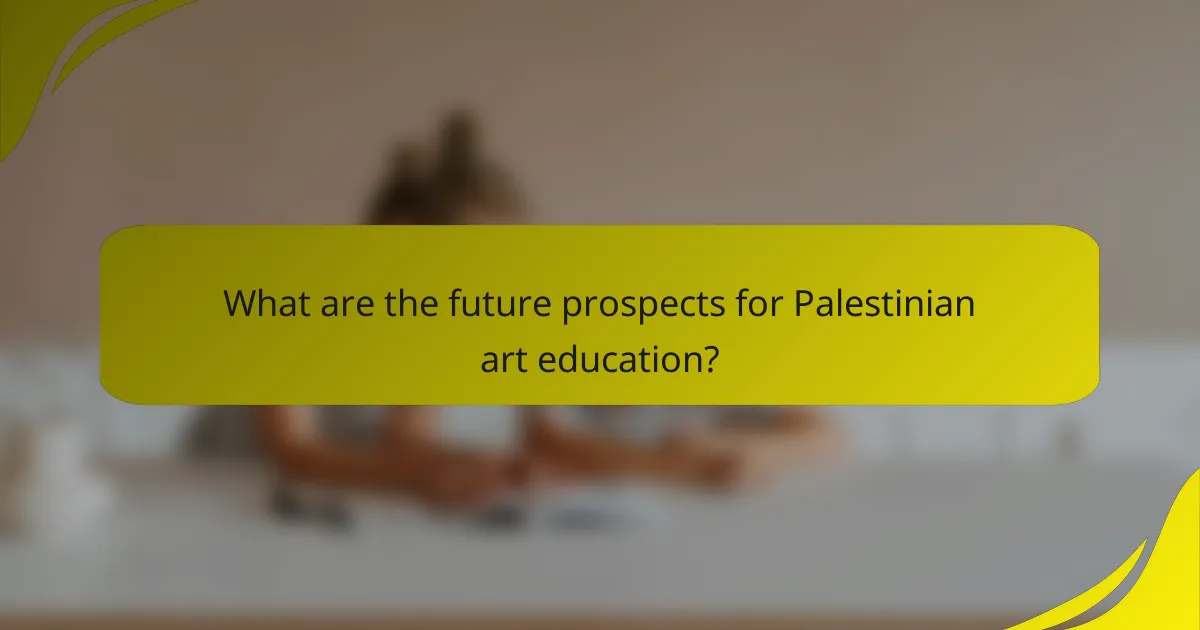
What are the future prospects for Palestinian art education?
The future prospects for Palestinian art education are promising due to increasing local and international support. Initiatives from various organizations aim to enhance art programs in schools and universities. The growing interest in Palestinian culture fosters a conducive environment for artistic expression. Collaborative projects with global art institutions provide valuable resources and exposure. Additionally, digital platforms facilitate broader access to art education. The resilience of Palestinian artists inspires new generations to pursue art. Increased funding from NGOs and cultural exchanges boosts educational opportunities. Overall, these factors contribute to a vibrant future for Palestinian art education.
How can Palestinian art education evolve in response to current challenges?
Palestinian art education can evolve by integrating contemporary issues into curricula. This approach can foster critical thinking and creativity among students. Additionally, incorporating digital tools and platforms can enhance accessibility and engagement. Collaborations with international art institutions can provide exposure to diverse perspectives. Furthermore, community-based projects can strengthen local identities and resilience. Research indicates that art education can promote social change and empowerment. For instance, programs in conflict zones have demonstrated positive impacts on youth engagement and expression.
What innovative approaches are being explored in Palestinian art education?
Innovative approaches in Palestinian art education include integrating technology and community engagement. Programs utilize digital tools to enhance creative expression. Art educators are collaborating with local communities to foster cultural identity. Workshops often focus on traditional techniques combined with contemporary practices. These methods aim to empower students and promote critical thinking. Research indicates that such initiatives improve artistic skills and cultural awareness. Institutions are also incorporating interdisciplinary studies to broaden the educational scope. This holistic approach nurtures both artistic talent and social consciousness among students.
What best practices can enhance Palestinian art education?
Integrating community involvement can enhance Palestinian art education. Involving local artists fosters a connection between students and their cultural heritage. This practice encourages mentorship opportunities, allowing students to learn directly from experienced practitioners. Incorporating diverse art forms, such as traditional crafts and contemporary techniques, enriches the curriculum. Providing access to art supplies and resources is essential for practical learning. Establishing partnerships with art institutions can offer students exposure to broader artistic perspectives. Organizing exhibitions and showcases promotes student work and builds confidence. Finally, implementing art education in schools can ensure consistent access to quality instruction. These practices contribute to a more robust and culturally relevant art education system in Palestine.
How can collaboration with international art institutions benefit Palestinian art education?
Collaboration with international art institutions can significantly enhance Palestinian art education. It provides access to global resources and expertise. International partnerships can facilitate workshops and training programs. These initiatives can introduce new techniques and perspectives to Palestinian artists and educators. Exposure to diverse art practices can enrich the local curriculum. Collaborative exhibitions can showcase Palestinian art on a global stage. This visibility can attract funding and support for local art initiatives. Increased recognition can lead to greater opportunities for Palestinian artists in the international art community.
What role does technology play in the future of Palestinian art education?
Technology plays a transformative role in the future of Palestinian art education. It enhances access to resources and learning platforms. Digital tools enable remote learning, allowing students to connect with global art communities. Online workshops and courses provide diverse artistic perspectives. Technology also facilitates the documentation and preservation of Palestinian art. Virtual galleries can showcase local artists to a broader audience. Social media platforms help in promoting Palestinian art and culture. These advancements support the development of new artistic techniques and collaborations. Overall, technology fosters innovation and resilience in Palestinian art education.
The main entity of the article is Palestinian art education, which has undergone significant historical evolution since the early 20th century. The article outlines key movements and influential figures that have shaped this educational landscape, including the emergence of formal institutions, the impact of socio-political events, and the integration of traditional and contemporary practices. It also discusses the cultural impact of art education on Palestinian identity, the challenges faced due to political instability, and the future prospects for artistic development. Through this comprehensive overview, the article highlights the resilience and creativity inherent in Palestinian art education amidst ongoing challenges.
